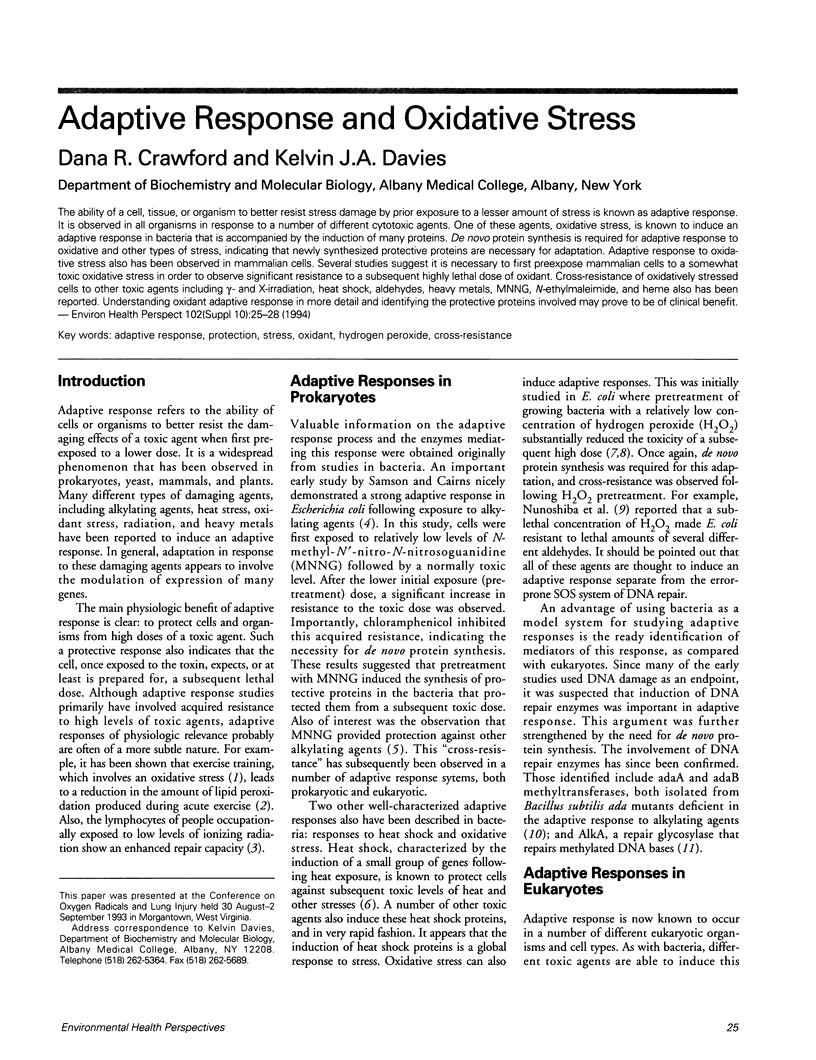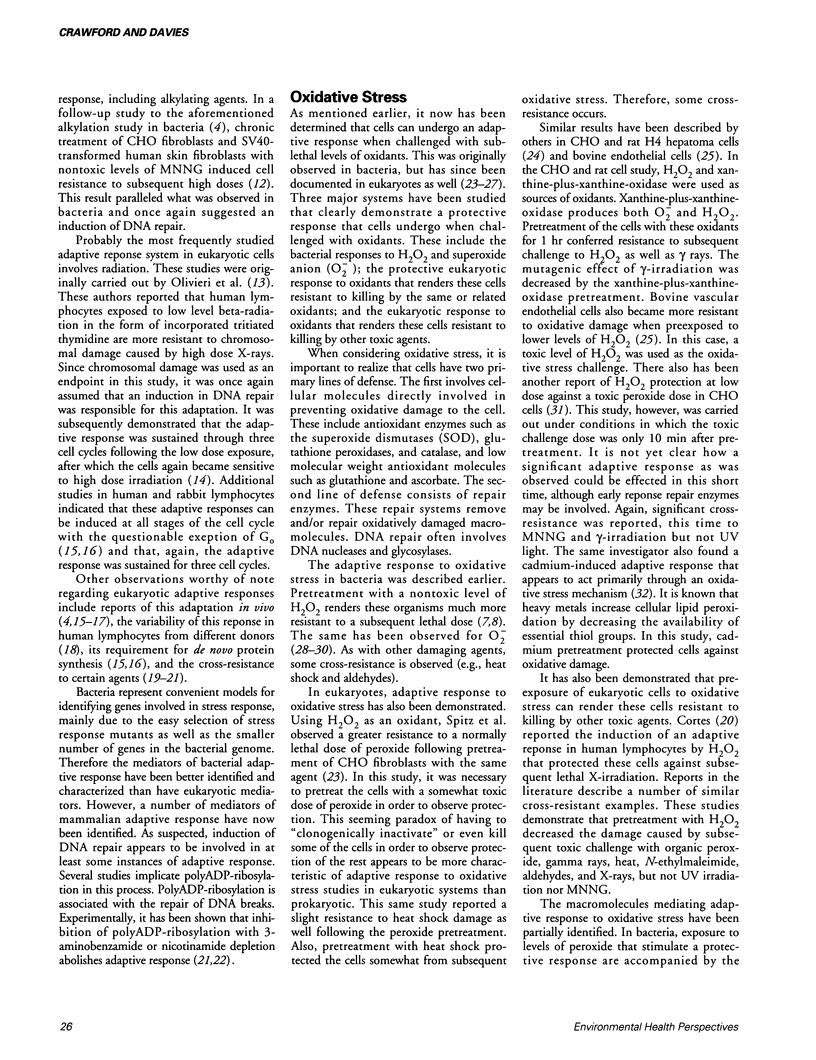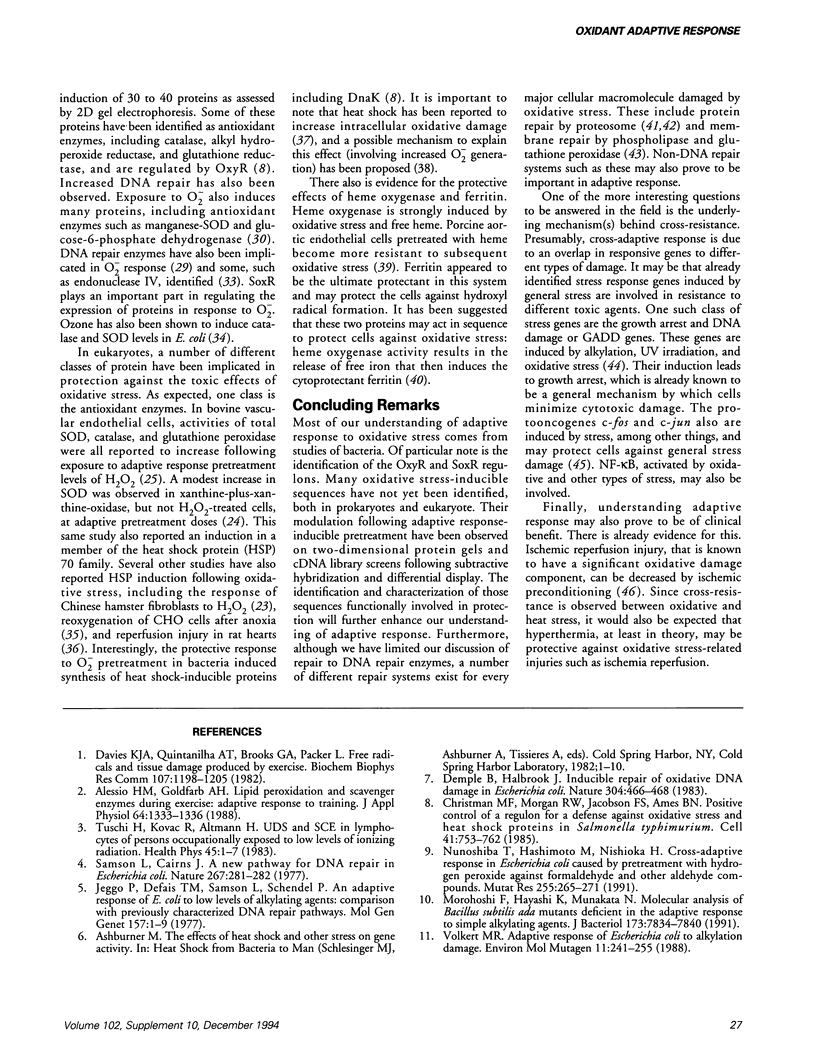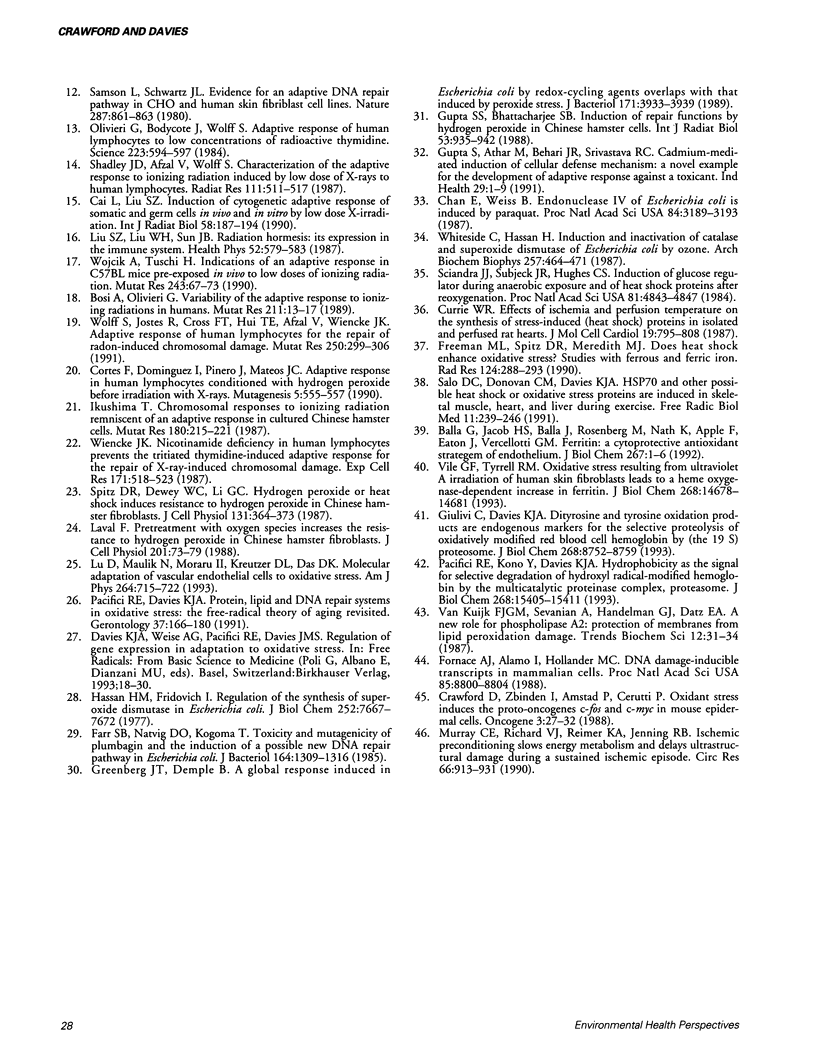Abstract
The ability of a cell, tissue, or organism to better resist stress damage by prior exposure to a lesser amount of stress is known as adaptive response. It is observed in all organisms in response to a number of different cytotoxic agents. One of these agents, oxidative stress, is known to induce an adaptive response in bacteria that is accompanied by the induction of many proteins. De novo protein synthesis is required for adaptive response to oxidative and other types of stress, indicating that newly synthesized protective proteins are necessary for adaptation. Adaptive response to oxidative stress also has been observed in mammalian cells. Several studies suggest it is necessary to first preexpose mammalian cells to a somewhat toxic oxidative stress in order to observe significant resistance to a subsequent highly lethal dose of oxidant. Cross-resistance of oxidatively stressed cells to other toxic agents including gamma- and X-irradiation, heat shock, aldehydes, heavy metals, MNNG, N-ethylmaleimide, and heme also has been reported. Understanding oxidant adaptive response in more detail and identifying the protective proteins involved may prove to be of clinical benefit.
Full text
PDF



Selected References
These references are in PubMed. This may not be the complete list of references from this article.
- Alessio H. M., Goldfarb A. H. Lipid peroxidation and scavenger enzymes during exercise: adaptive response to training. J Appl Physiol (1985) 1988 Apr;64(4):1333–1336. doi: 10.1152/jappl.1988.64.4.1333. [DOI] [PubMed] [Google Scholar]
- Bosi A., Olivieri G. Variability of the adaptive response to ionizing radiations in humans. Mutat Res. 1989 Mar;211(1):13–17. doi: 10.1016/0027-5107(89)90102-4. [DOI] [PubMed] [Google Scholar]
- Cai L., Liu S. Z. Induction of cytogenetic adaptive response of somatic and germ cells in vivo and in vitro by low-dose X-irradiation. Int J Radiat Biol. 1990 Jul;58(1):187–194. doi: 10.1080/09553009014551541. [DOI] [PubMed] [Google Scholar]
- Chan E., Weiss B. Endonuclease IV of Escherichia coli is induced by paraquat. Proc Natl Acad Sci U S A. 1987 May;84(10):3189–3193. doi: 10.1073/pnas.84.10.3189. [DOI] [PMC free article] [PubMed] [Google Scholar]
- Christman M. F., Morgan R. W., Jacobson F. S., Ames B. N. Positive control of a regulon for defenses against oxidative stress and some heat-shock proteins in Salmonella typhimurium. Cell. 1985 Jul;41(3):753–762. doi: 10.1016/s0092-8674(85)80056-8. [DOI] [PubMed] [Google Scholar]
- Cortés F., Dominguez I., Piñero J., Mateos J. C. Adaptive response in human lymphocytes conditioned with hydrogen peroxide before irradiation with X-rays. Mutagenesis. 1990 Nov;5(6):555–557. doi: 10.1093/mutage/5.6.555. [DOI] [PubMed] [Google Scholar]
- Currie R. W. Effects of ischemia and perfusion temperature on the synthesis of stress-induced (heat shock) proteins in isolated and perfused rat hearts. J Mol Cell Cardiol. 1987 Aug;19(8):795–808. doi: 10.1016/s0022-2828(87)80390-5. [DOI] [PubMed] [Google Scholar]
- Davies K. J., Quintanilha A. T., Brooks G. A., Packer L. Free radicals and tissue damage produced by exercise. Biochem Biophys Res Commun. 1982 Aug 31;107(4):1198–1205. doi: 10.1016/s0006-291x(82)80124-1. [DOI] [PubMed] [Google Scholar]
- Demple B., Halbrook J. Inducible repair of oxidative DNA damage in Escherichia coli. Nature. 1983 Aug 4;304(5925):466–468. doi: 10.1038/304466a0. [DOI] [PubMed] [Google Scholar]
- Farr S. B., Natvig D. O., Kogoma T. Toxicity and mutagenicity of plumbagin and the induction of a possible new DNA repair pathway in Escherichia coli. J Bacteriol. 1985 Dec;164(3):1309–1316. doi: 10.1128/jb.164.3.1309-1316.1985. [DOI] [PMC free article] [PubMed] [Google Scholar]
- Fornace A. J., Jr, Alamo I., Jr, Hollander M. C. DNA damage-inducible transcripts in mammalian cells. Proc Natl Acad Sci U S A. 1988 Dec;85(23):8800–8804. doi: 10.1073/pnas.85.23.8800. [DOI] [PMC free article] [PubMed] [Google Scholar]
- Freeman M. L., Spitz D. R., Meredith M. J. Does heat shock enhance oxidative stress? Studies with ferrous and ferric iron. Radiat Res. 1990 Dec;124(3):288–293. [PubMed] [Google Scholar]
- Giulivi C., Davies K. J. Dityrosine and tyrosine oxidation products are endogenous markers for the selective proteolysis of oxidatively modified red blood cell hemoglobin by (the 19 S) proteasome. J Biol Chem. 1993 Apr 25;268(12):8752–8759. [PubMed] [Google Scholar]
- Greenberg J. T., Demple B. A global response induced in Escherichia coli by redox-cycling agents overlaps with that induced by peroxide stress. J Bacteriol. 1989 Jul;171(7):3933–3939. doi: 10.1128/jb.171.7.3933-3939.1989. [DOI] [PMC free article] [PubMed] [Google Scholar]
- Gupta S., Athar M., Behari J. R., Srivastava R. C. Cadmium-mediated induction of cellular defence mechanism: a novel example for the development of adaptive response against a toxicant. Ind Health. 1991;29(1):1–9. doi: 10.2486/indhealth.29.1. [DOI] [PubMed] [Google Scholar]
- Hassan H. M., Fridovich I. Regulation of the synthesis of superoxide dismutase in Escherichia coli. Induction by methyl viologen. J Biol Chem. 1977 Nov 10;252(21):7667–7672. [PubMed] [Google Scholar]
- Ikushima T. Chromosomal responses to ionizing radiation reminiscent of an adaptive response in cultured Chinese hamster cells. Mutat Res. 1987 Oct;180(2):215–221. doi: 10.1016/0027-5107(87)90217-x. [DOI] [PubMed] [Google Scholar]
- Jeggo P., Defais T. M., Samson L., Schendel P. An adaptive response of E. coli to low levels of alkylating agent: comparison with previously characterised DNA repair pathways. Mol Gen Genet. 1977 Nov 29;157(1):1–9. doi: 10.1007/BF00268680. [DOI] [PubMed] [Google Scholar]
- Khorana H. G. Rhodopsin, photoreceptor of the rod cell. An emerging pattern for structure and function. J Biol Chem. 1992 Jan 5;267(1):1–4. [PubMed] [Google Scholar]
- Laval F. Pretreatment with oxygen species increases the resistance of mammalian cells to hydrogen peroxide and gamma-rays. Mutat Res. 1988 Sep;201(1):73–79. doi: 10.1016/0027-5107(88)90112-1. [DOI] [PubMed] [Google Scholar]
- Liu S. Z., Liu W. H., Sun J. B. Radiation hormesis: its expression in the immune system. Health Phys. 1987 May;52(5):579–583. doi: 10.1097/00004032-198705000-00008. [DOI] [PubMed] [Google Scholar]
- Morohoshi F., Hayashi K., Munakata N. Molecular analysis of Bacillus subtilis ada mutants deficient in the adaptive response to simple alkylating agents. J Bacteriol. 1991 Dec;173(24):7834–7840. doi: 10.1128/jb.173.24.7834-7840.1991. [DOI] [PMC free article] [PubMed] [Google Scholar]
- Murry C. E., Richard V. J., Reimer K. A., Jennings R. B. Ischemic preconditioning slows energy metabolism and delays ultrastructural damage during a sustained ischemic episode. Circ Res. 1990 Apr;66(4):913–931. doi: 10.1161/01.res.66.4.913. [DOI] [PubMed] [Google Scholar]
- Nunoshiba T., Hashimoto M., Nishioka H. Cross-adaptive response in Escherichia coli caused by pretreatment with H2O2 against formaldehyde and other aldehyde compounds. Mutat Res. 1991 Nov;255(3):265–271. doi: 10.1016/0921-8777(91)90030-s. [DOI] [PubMed] [Google Scholar]
- Olivieri G., Bodycote J., Wolff S. Adaptive response of human lymphocytes to low concentrations of radioactive thymidine. Science. 1984 Feb 10;223(4636):594–597. doi: 10.1126/science.6695170. [DOI] [PubMed] [Google Scholar]
- Pacifici R. E., Davies K. J. Protein, lipid and DNA repair systems in oxidative stress: the free-radical theory of aging revisited. Gerontology. 1991;37(1-3):166–180. doi: 10.1159/000213257. [DOI] [PubMed] [Google Scholar]
- Pacifici R. E., Kono Y., Davies K. J. Hydrophobicity as the signal for selective degradation of hydroxyl radical-modified hemoglobin by the multicatalytic proteinase complex, proteasome. J Biol Chem. 1993 Jul 25;268(21):15405–15411. [PubMed] [Google Scholar]
- Salo D. C., Donovan C. M., Davies K. J. HSP70 and other possible heat shock or oxidative stress proteins are induced in skeletal muscle, heart, and liver during exercise. Free Radic Biol Med. 1991;11(3):239–246. doi: 10.1016/0891-5849(91)90119-n. [DOI] [PubMed] [Google Scholar]
- Samson L., Cairns J. A new pathway for DNA repair in Escherichia coli. Nature. 1977 May 19;267(5608):281–283. doi: 10.1038/267281a0. [DOI] [PubMed] [Google Scholar]
- Samson L., Schwartz J. L. Evidence for an adaptive DNA repair pathway in CHO and human skin fibroblast cell lines. Nature. 1980 Oct 30;287(5785):861–863. doi: 10.1038/287861a0. [DOI] [PubMed] [Google Scholar]
- Sciandra J. J., Subjeck J. R., Hughes C. S. Induction of glucose-regulated proteins during anaerobic exposure and of heat-shock proteins after reoxygenation. Proc Natl Acad Sci U S A. 1984 Aug;81(15):4843–4847. doi: 10.1073/pnas.81.15.4843. [DOI] [PMC free article] [PubMed] [Google Scholar]
- Sen Gupta S., Bhattacharjee S. B. Induction of repair functions by hydrogen peroxide in Chinese hamster cells. Int J Radiat Biol Relat Stud Phys Chem Med. 1988 Jun;53(6):935–942. doi: 10.1080/09553008814551301. [DOI] [PubMed] [Google Scholar]
- Shadley J. D., Afzal V., Wolff S. Characterization of the adaptive response to ionizing radiation induced by low doses of X rays to human lymphocytes. Radiat Res. 1987 Sep;111(3):511–517. [PubMed] [Google Scholar]
- Spitz D. R., Dewey W. C., Li G. C. Hydrogen peroxide or heat shock induces resistance to hydrogen peroxide in Chinese hamster fibroblasts. J Cell Physiol. 1987 Jun;131(3):364–373. doi: 10.1002/jcp.1041310308. [DOI] [PubMed] [Google Scholar]
- Tuschl H., Kovac R., Altmann H. UDS and SCE in lymphocytes of persons occupationally exposed to low levels of ionizing radiation. Health Phys. 1983 Jul;45(1):1–7. doi: 10.1097/00004032-198307000-00001. [DOI] [PubMed] [Google Scholar]
- Vile G. F., Tyrrell R. M. Oxidative stress resulting from ultraviolet A irradiation of human skin fibroblasts leads to a heme oxygenase-dependent increase in ferritin. J Biol Chem. 1993 Jul 15;268(20):14678–14681. [PubMed] [Google Scholar]
- Volkert M. R. Adaptive response of Escherichia coli to alkylation damage. Environ Mol Mutagen. 1988;11(2):241–255. doi: 10.1002/em.2850110210. [DOI] [PubMed] [Google Scholar]
- Whiteside C., Hassan H. M. Induction and inactivation of catalase and superoxide dismutase of Escherichia coli by ozone. Arch Biochem Biophys. 1987 Sep;257(2):464–471. doi: 10.1016/0003-9861(87)90591-1. [DOI] [PubMed] [Google Scholar]
- Wiencke J. K. Nicotinamide deficiency in human lymphocytes prevents the [3H]thymidine-induced adaptive response for the repair of X-ray-induced chromosomal damage. Exp Cell Res. 1987 Aug;171(2):518–523. doi: 10.1016/0014-4827(87)90185-6. [DOI] [PubMed] [Google Scholar]
- Wojcik A., Tuschl H. Indications of an adaptive response in C57BL mice pre-exposed in vivo to low doses of ionizing radiation. Mutat Res. 1990 Jan;243(1):67–73. doi: 10.1016/0165-7992(90)90125-4. [DOI] [PubMed] [Google Scholar]
- Wolff S., Jostes R., Cross F. T., Hui T. E., Afzal V., Wiencke J. K. Adaptive response of human lymphocytes for the repair of radon-induced chromosomal damage. Mutat Res. 1991 Sep-Oct;250(1-2):299–306. doi: 10.1016/0027-5107(91)90185-q. [DOI] [PubMed] [Google Scholar]


